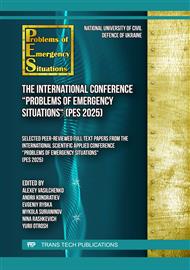[1]
О. Proskurnin, N. Tsapko, Т. Ivashchenko, S. Vasilenko, K. Belokon, N. Zakharchenko, A. Yurchenko, N. Teliura, Standardizing the Wastewater Composition in Order to Minimize the Eutrophication Risk for the Reservoir. Journal of Ecological Engineering. 25(6) (2024) 144–152. https:// doi.org/
DOI: 10.12911/22998993/186822
Google Scholar
[2]
M. Malovanyy, O. Palamarchuk, I. Trach, H. Petruk, H. Sakalova, Kh. Soloviy, T. Vasylinych, I. Tymchuk, N. Vronska Adsorption Extraction of Chromium Ions (III) with the Help of Bentonite Clays. Journal of Ecological Engineering. 21(7) 2020 178–185. https://doi.org/.
DOI: 10.12911/22998993/125545
Google Scholar
[3]
S. Shamanskyi, S. Boichenko, I. Nezbrytska, L. Pavliukh, Cultivating of microalgae in wastewaters for biofuel and fertilizer production. Chemmotological Aspects of Sustainable Development of Transport. Springer. (2022) 81-99
DOI: 10.1007/978-3-031-06577-4
Google Scholar
[4]
L. Pavliukh, S. Shamanskyi, S. Boichenko, A. Jaworski, Evaluation of the potential of commercial use of microalgae in the world and in Ukraine. Aircraft Engineering and Aerospace Technology. 93 (3) (2021)
DOI: 10.1108/AEAT-08-2020-0181
Google Scholar
[5]
I. Nezbrytska, S. Shamanskyi, L. Pavliukh, G. Kharchenko, Assessment of inorganic nitrogen and phosphorous compounds removal efficiency from different types of waste water using microalgae cultures. Oceanological and Hydrobiological Studies. 51 (1) (2022) 45–52
DOI: 10.26881/oahs-2022.1.05
Google Scholar
[6]
I. Nezbrytska, S. Shamanskyi, L. Pavliukh, Z. Gorbunova, Application of Euglena gracilis in wastewater treatment processes. Biotechnologia. 103(4) (2022) 323–330
DOI: 10.5114/bta.2022.120702
Google Scholar
[7]
I. Nezbrytska, S. Shamanskyi, L. Pavliukh, Z. Gorbunova, O. Horbachova, V. Repeta, Removal of Biogenic Compounds from Sewage Water in a Culture of Euglena Gracilis (EUGLENOPHYTA) In: Boichenko, S., Zaporozhets, A., Yakovlieva, A., Shkilniuk, I. (eds) Modern Technologies in Energy and Transport. Studies in Systems, Decision and Control. Springer, Cham.. 510 (2024) 179–193
DOI: 10.1007/978-3-031-44351-0_9
Google Scholar
[8]
Dovidnyk z vodnykh resursiv/ B. I. Ctpelcya. K.: Upozhaj, 1987, 295 р. [in Ukrainian].
Google Scholar
[9]
Pro zatverdzhennya Normatyviv ekolohichnoyi bezpeky vodnykh obyektiv, shcho vykorystovuyutsya dlya potreb rybnoho hospodarstva, shchodo hranychno dopustymykh kontsentratsiy orhanichnykh ta mineralnykh rechovyn u morskykh ta prisnykh vodakh (biokhimichnoho spozhyvannya kysnyu (BSK-5), khimichnoho spozhyvannya kysnyu (KhSK), zavyslykh rechovyn ta amoniynoho azotu). Nakaz Minahropolityky N 471, 30.07.2012 http://www.leonorm.com.ua/P/NL_DOC/UA/201201/Nak471.htm. [in Ukrainian].
Google Scholar
[10]
O. Proskurnin, I. Kirpicheva, S. Smirnova, A method of establishing regional standards of surface water quality under anthropogenic loads. Eastern-European Journal of Enterprise Technologies. 4(10–82) (2016) 24–30.
DOI: 10.15587/1729-4061.2016.73540
Google Scholar


